Comparative Analysis: Healthcare Systems in the US, UK, Australia
VerifiedAdded on 2023/06/12
|18
|5088
|160
Report
AI Summary
This report provides a comparative analysis of the healthcare systems in the United States, the United Kingdom, and Australia, focusing on their governance, structure, funding, and effectiveness. It highlights the differences in approaches to healthcare, with the US relying heavily on private funding and lacking universal coverage, while the UK and Australia have universal healthcare systems funded primarily by the government. The UK's National Health Service is noted for its efficiency and equity, while the US spends significantly more on healthcare per capita but lags in overall effectiveness and access. The report evaluates the strengths and weaknesses of each system, concluding that while the US has high funding, the UK's system is the most effective, and Australia is striving to improve through ongoing reforms and culturally appropriate care. Desklib offers this report as a resource for students studying healthcare systems, along with a wide range of past papers and solved assignments.
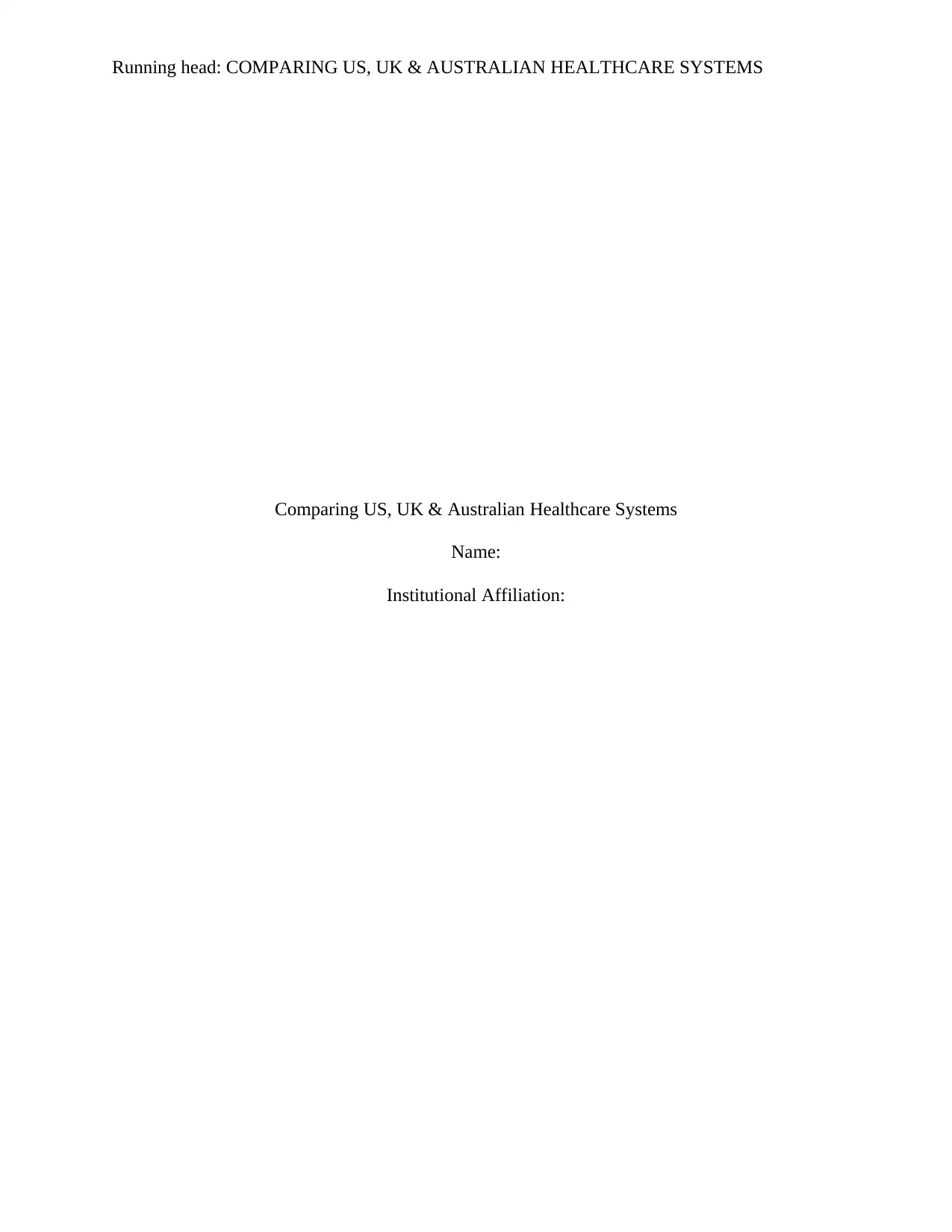
Running head: COMPARING US, UK & AUSTRALIAN HEALTHCARE SYSTEMS
Comparing US, UK & Australian Healthcare Systems
Name:
Institutional Affiliation:
Comparing US, UK & Australian Healthcare Systems
Name:
Institutional Affiliation:
Paraphrase This Document
Need a fresh take? Get an instant paraphrase of this document with our AI Paraphraser
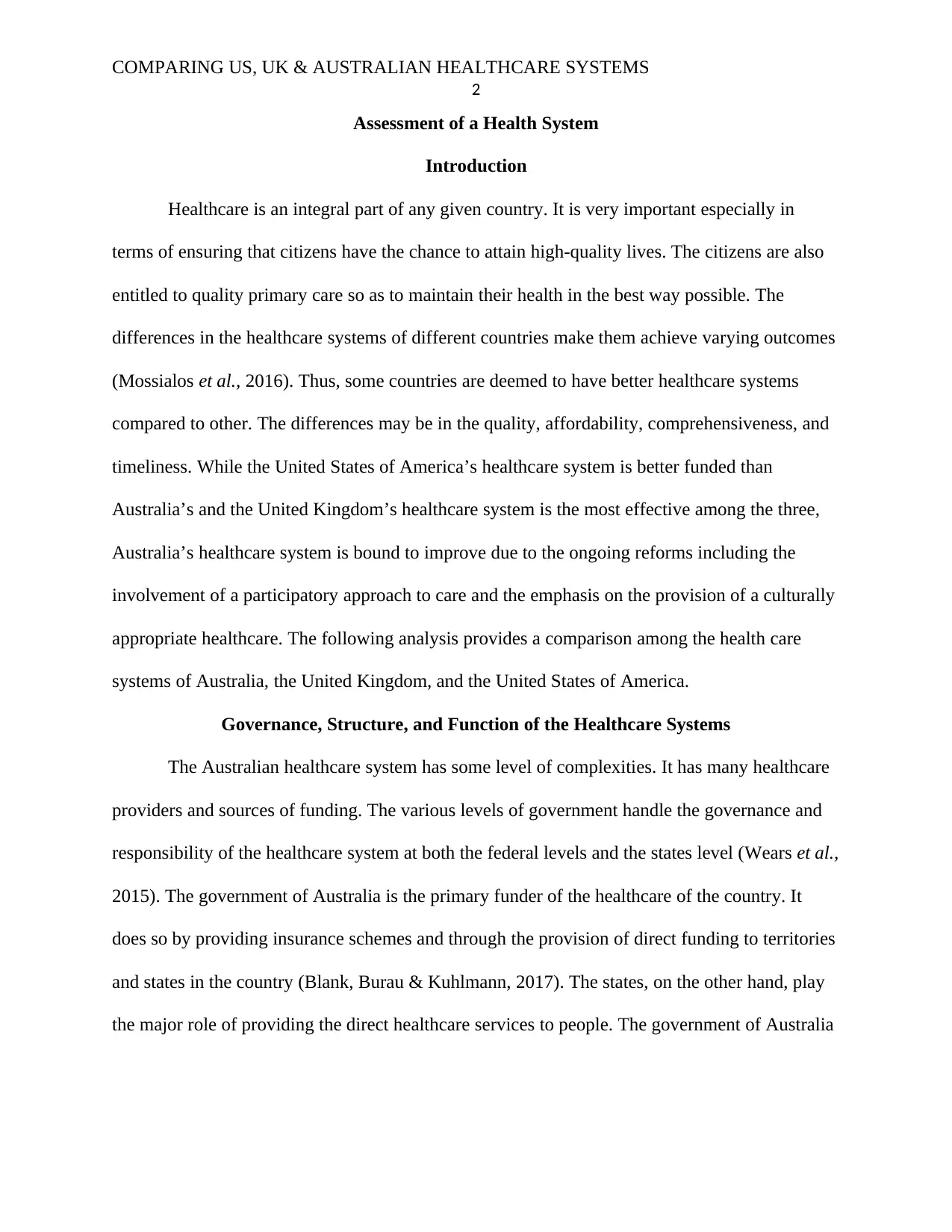
COMPARING US, UK & AUSTRALIAN HEALTHCARE SYSTEMS
2
Assessment of a Health System
Introduction
Healthcare is an integral part of any given country. It is very important especially in
terms of ensuring that citizens have the chance to attain high-quality lives. The citizens are also
entitled to quality primary care so as to maintain their health in the best way possible. The
differences in the healthcare systems of different countries make them achieve varying outcomes
(Mossialos et al., 2016). Thus, some countries are deemed to have better healthcare systems
compared to other. The differences may be in the quality, affordability, comprehensiveness, and
timeliness. While the United States of America’s healthcare system is better funded than
Australia’s and the United Kingdom’s healthcare system is the most effective among the three,
Australia’s healthcare system is bound to improve due to the ongoing reforms including the
involvement of a participatory approach to care and the emphasis on the provision of a culturally
appropriate healthcare. The following analysis provides a comparison among the health care
systems of Australia, the United Kingdom, and the United States of America.
Governance, Structure, and Function of the Healthcare Systems
The Australian healthcare system has some level of complexities. It has many healthcare
providers and sources of funding. The various levels of government handle the governance and
responsibility of the healthcare system at both the federal levels and the states level (Wears et al.,
2015). The government of Australia is the primary funder of the healthcare of the country. It
does so by providing insurance schemes and through the provision of direct funding to territories
and states in the country (Blank, Burau & Kuhlmann, 2017). The states, on the other hand, play
the major role of providing the direct healthcare services to people. The government of Australia
2
Assessment of a Health System
Introduction
Healthcare is an integral part of any given country. It is very important especially in
terms of ensuring that citizens have the chance to attain high-quality lives. The citizens are also
entitled to quality primary care so as to maintain their health in the best way possible. The
differences in the healthcare systems of different countries make them achieve varying outcomes
(Mossialos et al., 2016). Thus, some countries are deemed to have better healthcare systems
compared to other. The differences may be in the quality, affordability, comprehensiveness, and
timeliness. While the United States of America’s healthcare system is better funded than
Australia’s and the United Kingdom’s healthcare system is the most effective among the three,
Australia’s healthcare system is bound to improve due to the ongoing reforms including the
involvement of a participatory approach to care and the emphasis on the provision of a culturally
appropriate healthcare. The following analysis provides a comparison among the health care
systems of Australia, the United Kingdom, and the United States of America.
Governance, Structure, and Function of the Healthcare Systems
The Australian healthcare system has some level of complexities. It has many healthcare
providers and sources of funding. The various levels of government handle the governance and
responsibility of the healthcare system at both the federal levels and the states level (Wears et al.,
2015). The government of Australia is the primary funder of the healthcare of the country. It
does so by providing insurance schemes and through the provision of direct funding to territories
and states in the country (Blank, Burau & Kuhlmann, 2017). The states, on the other hand, play
the major role of providing the direct healthcare services to people. The government of Australia
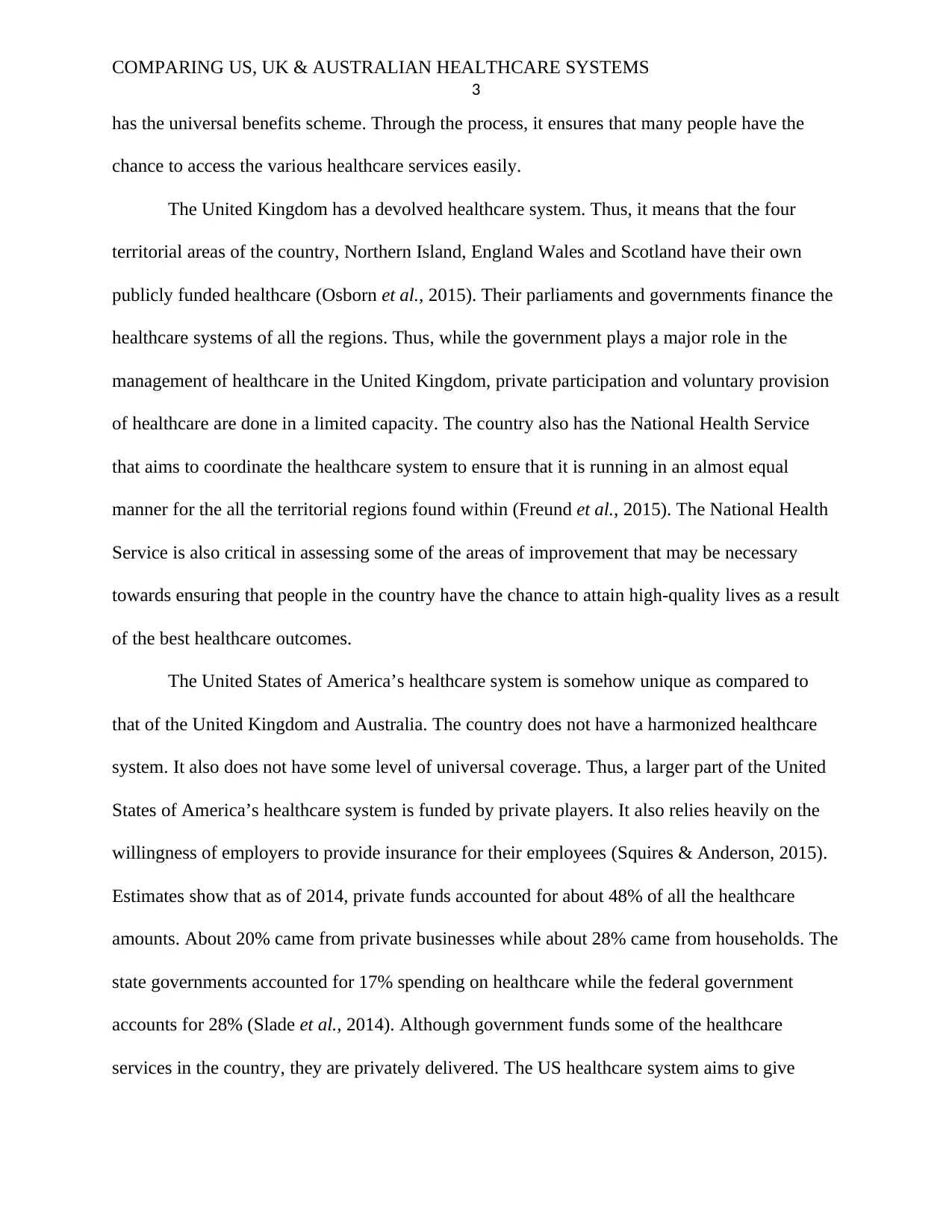
COMPARING US, UK & AUSTRALIAN HEALTHCARE SYSTEMS
3
has the universal benefits scheme. Through the process, it ensures that many people have the
chance to access the various healthcare services easily.
The United Kingdom has a devolved healthcare system. Thus, it means that the four
territorial areas of the country, Northern Island, England Wales and Scotland have their own
publicly funded healthcare (Osborn et al., 2015). Their parliaments and governments finance the
healthcare systems of all the regions. Thus, while the government plays a major role in the
management of healthcare in the United Kingdom, private participation and voluntary provision
of healthcare are done in a limited capacity. The country also has the National Health Service
that aims to coordinate the healthcare system to ensure that it is running in an almost equal
manner for the all the territorial regions found within (Freund et al., 2015). The National Health
Service is also critical in assessing some of the areas of improvement that may be necessary
towards ensuring that people in the country have the chance to attain high-quality lives as a result
of the best healthcare outcomes.
The United States of America’s healthcare system is somehow unique as compared to
that of the United Kingdom and Australia. The country does not have a harmonized healthcare
system. It also does not have some level of universal coverage. Thus, a larger part of the United
States of America’s healthcare system is funded by private players. It also relies heavily on the
willingness of employers to provide insurance for their employees (Squires & Anderson, 2015).
Estimates show that as of 2014, private funds accounted for about 48% of all the healthcare
amounts. About 20% came from private businesses while about 28% came from households. The
state governments accounted for 17% spending on healthcare while the federal government
accounts for 28% (Slade et al., 2014). Although government funds some of the healthcare
services in the country, they are privately delivered. The US healthcare system aims to give
3
has the universal benefits scheme. Through the process, it ensures that many people have the
chance to access the various healthcare services easily.
The United Kingdom has a devolved healthcare system. Thus, it means that the four
territorial areas of the country, Northern Island, England Wales and Scotland have their own
publicly funded healthcare (Osborn et al., 2015). Their parliaments and governments finance the
healthcare systems of all the regions. Thus, while the government plays a major role in the
management of healthcare in the United Kingdom, private participation and voluntary provision
of healthcare are done in a limited capacity. The country also has the National Health Service
that aims to coordinate the healthcare system to ensure that it is running in an almost equal
manner for the all the territorial regions found within (Freund et al., 2015). The National Health
Service is also critical in assessing some of the areas of improvement that may be necessary
towards ensuring that people in the country have the chance to attain high-quality lives as a result
of the best healthcare outcomes.
The United States of America’s healthcare system is somehow unique as compared to
that of the United Kingdom and Australia. The country does not have a harmonized healthcare
system. It also does not have some level of universal coverage. Thus, a larger part of the United
States of America’s healthcare system is funded by private players. It also relies heavily on the
willingness of employers to provide insurance for their employees (Squires & Anderson, 2015).
Estimates show that as of 2014, private funds accounted for about 48% of all the healthcare
amounts. About 20% came from private businesses while about 28% came from households. The
state governments accounted for 17% spending on healthcare while the federal government
accounts for 28% (Slade et al., 2014). Although government funds some of the healthcare
services in the country, they are privately delivered. The US healthcare system aims to give
⊘ This is a preview!⊘
Do you want full access?
Subscribe today to unlock all pages.

Trusted by 1+ million students worldwide
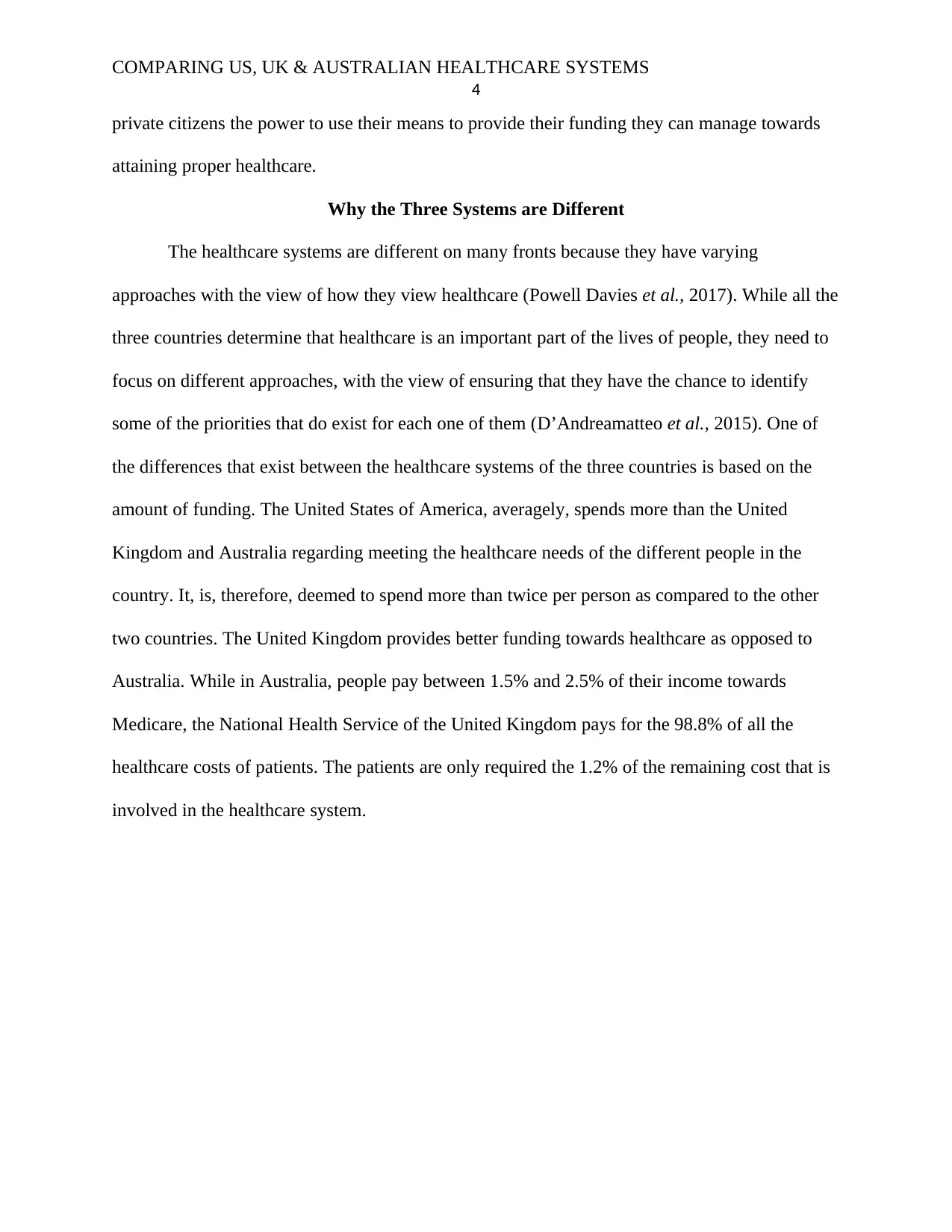
COMPARING US, UK & AUSTRALIAN HEALTHCARE SYSTEMS
4
private citizens the power to use their means to provide their funding they can manage towards
attaining proper healthcare.
Why the Three Systems are Different
The healthcare systems are different on many fronts because they have varying
approaches with the view of how they view healthcare (Powell Davies et al., 2017). While all the
three countries determine that healthcare is an important part of the lives of people, they need to
focus on different approaches, with the view of ensuring that they have the chance to identify
some of the priorities that do exist for each one of them (D’Andreamatteo et al., 2015). One of
the differences that exist between the healthcare systems of the three countries is based on the
amount of funding. The United States of America, averagely, spends more than the United
Kingdom and Australia regarding meeting the healthcare needs of the different people in the
country. It, is, therefore, deemed to spend more than twice per person as compared to the other
two countries. The United Kingdom provides better funding towards healthcare as opposed to
Australia. While in Australia, people pay between 1.5% and 2.5% of their income towards
Medicare, the National Health Service of the United Kingdom pays for the 98.8% of all the
healthcare costs of patients. The patients are only required the 1.2% of the remaining cost that is
involved in the healthcare system.
4
private citizens the power to use their means to provide their funding they can manage towards
attaining proper healthcare.
Why the Three Systems are Different
The healthcare systems are different on many fronts because they have varying
approaches with the view of how they view healthcare (Powell Davies et al., 2017). While all the
three countries determine that healthcare is an important part of the lives of people, they need to
focus on different approaches, with the view of ensuring that they have the chance to identify
some of the priorities that do exist for each one of them (D’Andreamatteo et al., 2015). One of
the differences that exist between the healthcare systems of the three countries is based on the
amount of funding. The United States of America, averagely, spends more than the United
Kingdom and Australia regarding meeting the healthcare needs of the different people in the
country. It, is, therefore, deemed to spend more than twice per person as compared to the other
two countries. The United Kingdom provides better funding towards healthcare as opposed to
Australia. While in Australia, people pay between 1.5% and 2.5% of their income towards
Medicare, the National Health Service of the United Kingdom pays for the 98.8% of all the
healthcare costs of patients. The patients are only required the 1.2% of the remaining cost that is
involved in the healthcare system.
Paraphrase This Document
Need a fresh take? Get an instant paraphrase of this document with our AI Paraphraser
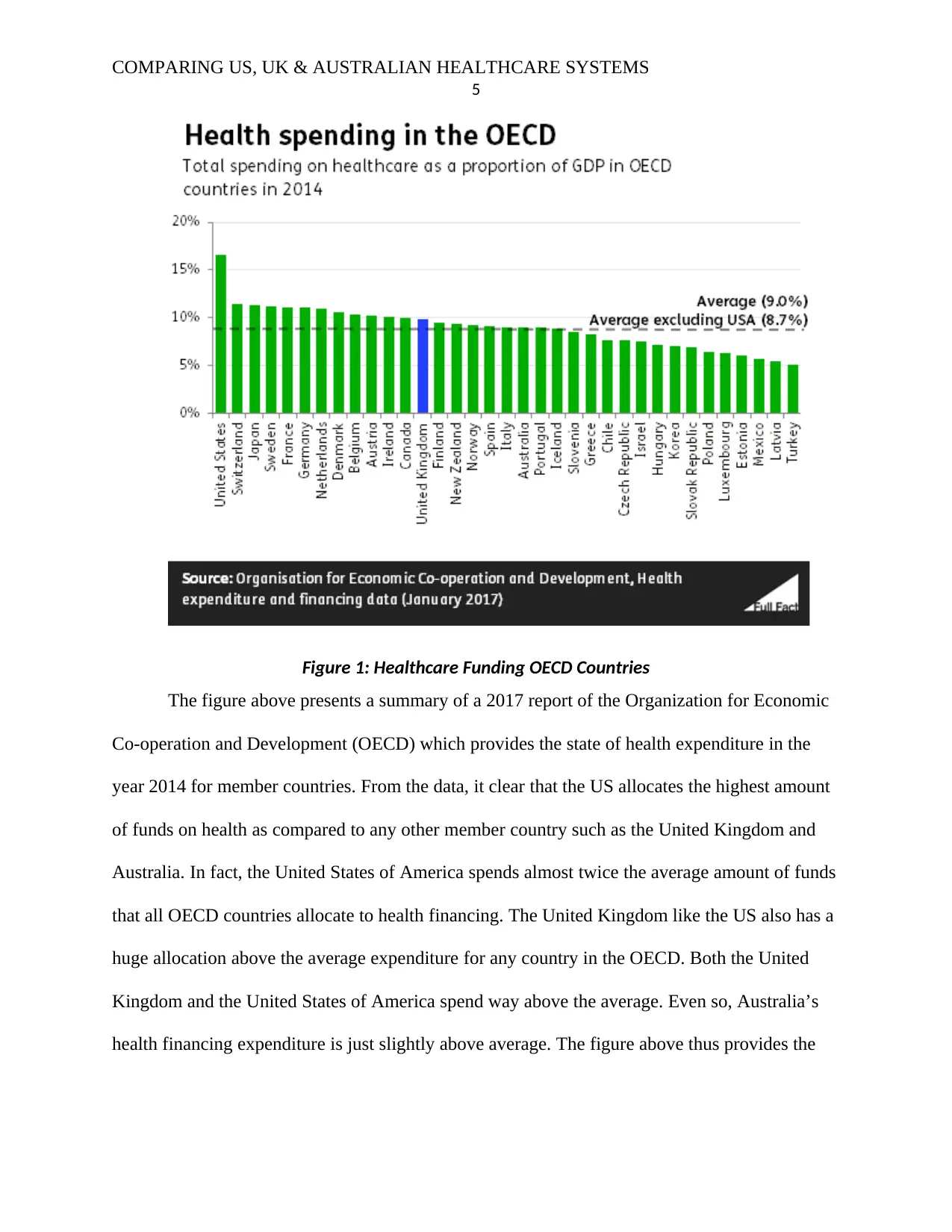
COMPARING US, UK & AUSTRALIAN HEALTHCARE SYSTEMS
5
Figure 1: Healthcare Funding OECD Countries
The figure above presents a summary of a 2017 report of the Organization for Economic
Co-operation and Development (OECD) which provides the state of health expenditure in the
year 2014 for member countries. From the data, it clear that the US allocates the highest amount
of funds on health as compared to any other member country such as the United Kingdom and
Australia. In fact, the United States of America spends almost twice the average amount of funds
that all OECD countries allocate to health financing. The United Kingdom like the US also has a
huge allocation above the average expenditure for any country in the OECD. Both the United
Kingdom and the United States of America spend way above the average. Even so, Australia’s
health financing expenditure is just slightly above average. The figure above thus provides the
5
Figure 1: Healthcare Funding OECD Countries
The figure above presents a summary of a 2017 report of the Organization for Economic
Co-operation and Development (OECD) which provides the state of health expenditure in the
year 2014 for member countries. From the data, it clear that the US allocates the highest amount
of funds on health as compared to any other member country such as the United Kingdom and
Australia. In fact, the United States of America spends almost twice the average amount of funds
that all OECD countries allocate to health financing. The United Kingdom like the US also has a
huge allocation above the average expenditure for any country in the OECD. Both the United
Kingdom and the United States of America spend way above the average. Even so, Australia’s
health financing expenditure is just slightly above average. The figure above thus provides the
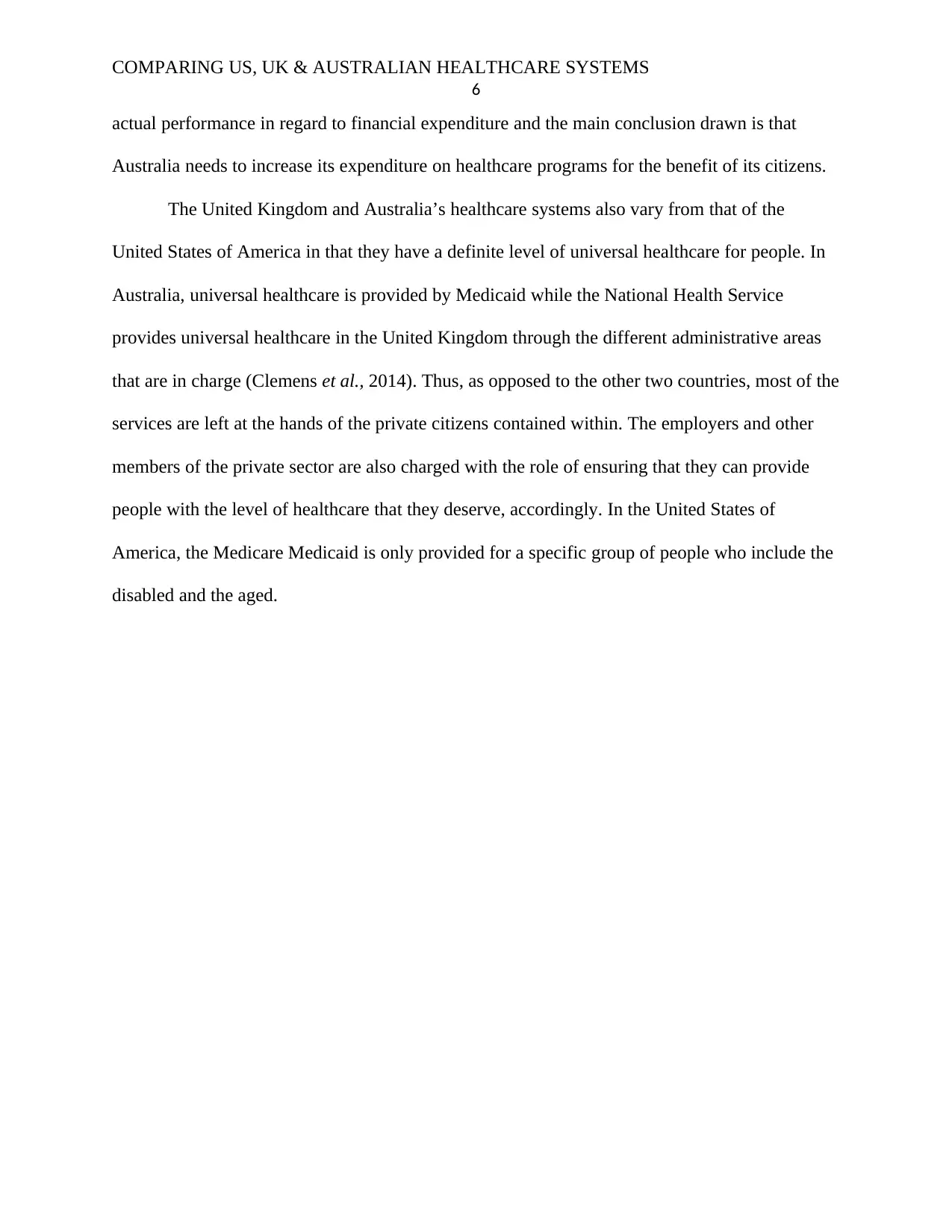
COMPARING US, UK & AUSTRALIAN HEALTHCARE SYSTEMS
6
actual performance in regard to financial expenditure and the main conclusion drawn is that
Australia needs to increase its expenditure on healthcare programs for the benefit of its citizens.
The United Kingdom and Australia’s healthcare systems also vary from that of the
United States of America in that they have a definite level of universal healthcare for people. In
Australia, universal healthcare is provided by Medicaid while the National Health Service
provides universal healthcare in the United Kingdom through the different administrative areas
that are in charge (Clemens et al., 2014). Thus, as opposed to the other two countries, most of the
services are left at the hands of the private citizens contained within. The employers and other
members of the private sector are also charged with the role of ensuring that they can provide
people with the level of healthcare that they deserve, accordingly. In the United States of
America, the Medicare Medicaid is only provided for a specific group of people who include the
disabled and the aged.
6
actual performance in regard to financial expenditure and the main conclusion drawn is that
Australia needs to increase its expenditure on healthcare programs for the benefit of its citizens.
The United Kingdom and Australia’s healthcare systems also vary from that of the
United States of America in that they have a definite level of universal healthcare for people. In
Australia, universal healthcare is provided by Medicaid while the National Health Service
provides universal healthcare in the United Kingdom through the different administrative areas
that are in charge (Clemens et al., 2014). Thus, as opposed to the other two countries, most of the
services are left at the hands of the private citizens contained within. The employers and other
members of the private sector are also charged with the role of ensuring that they can provide
people with the level of healthcare that they deserve, accordingly. In the United States of
America, the Medicare Medicaid is only provided for a specific group of people who include the
disabled and the aged.
⊘ This is a preview!⊘
Do you want full access?
Subscribe today to unlock all pages.

Trusted by 1+ million students worldwide
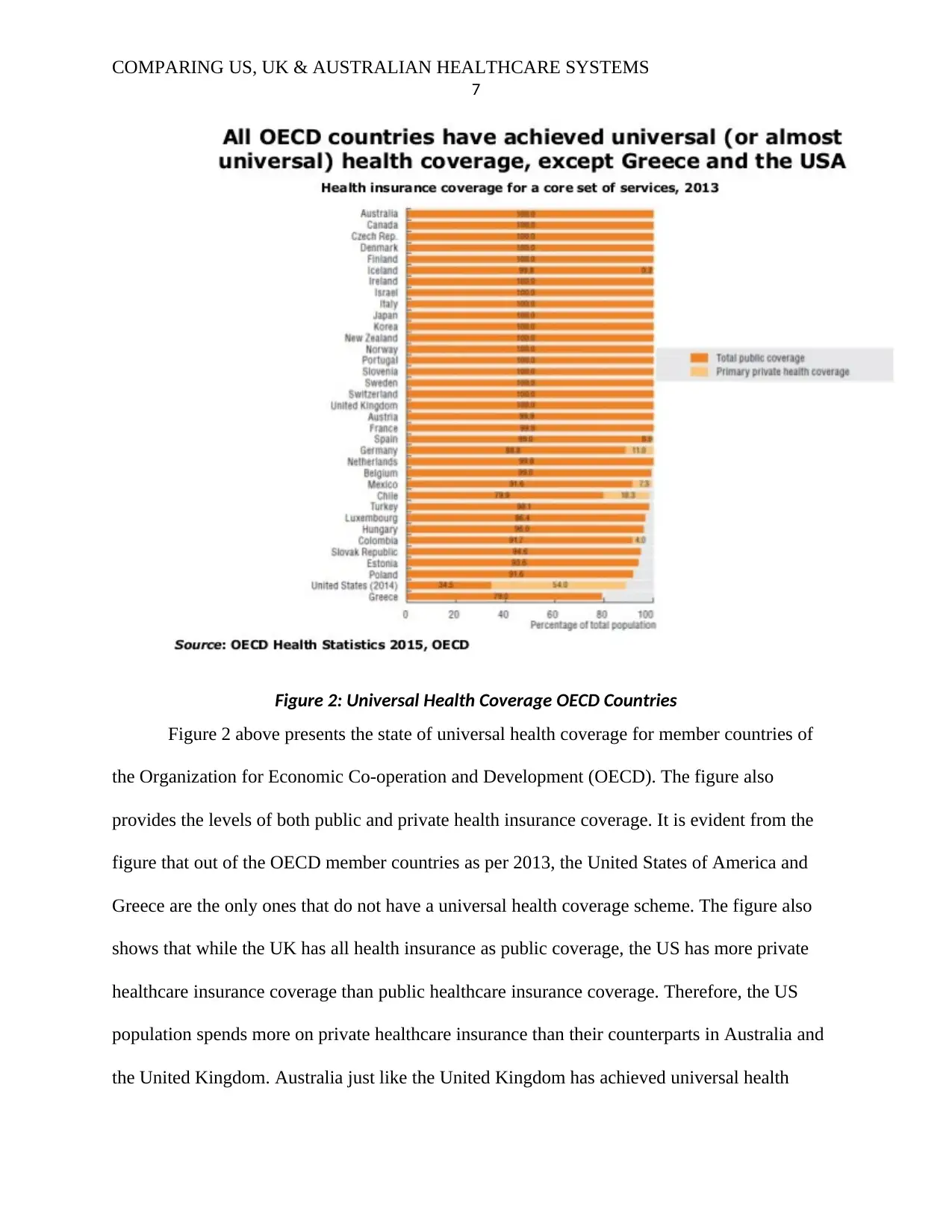
COMPARING US, UK & AUSTRALIAN HEALTHCARE SYSTEMS
7
Figure 2: Universal Health Coverage OECD Countries
Figure 2 above presents the state of universal health coverage for member countries of
the Organization for Economic Co-operation and Development (OECD). The figure also
provides the levels of both public and private health insurance coverage. It is evident from the
figure that out of the OECD member countries as per 2013, the United States of America and
Greece are the only ones that do not have a universal health coverage scheme. The figure also
shows that while the UK has all health insurance as public coverage, the US has more private
healthcare insurance coverage than public healthcare insurance coverage. Therefore, the US
population spends more on private healthcare insurance than their counterparts in Australia and
the United Kingdom. Australia just like the United Kingdom has achieved universal health
7
Figure 2: Universal Health Coverage OECD Countries
Figure 2 above presents the state of universal health coverage for member countries of
the Organization for Economic Co-operation and Development (OECD). The figure also
provides the levels of both public and private health insurance coverage. It is evident from the
figure that out of the OECD member countries as per 2013, the United States of America and
Greece are the only ones that do not have a universal health coverage scheme. The figure also
shows that while the UK has all health insurance as public coverage, the US has more private
healthcare insurance coverage than public healthcare insurance coverage. Therefore, the US
population spends more on private healthcare insurance than their counterparts in Australia and
the United Kingdom. Australia just like the United Kingdom has achieved universal health
Paraphrase This Document
Need a fresh take? Get an instant paraphrase of this document with our AI Paraphraser
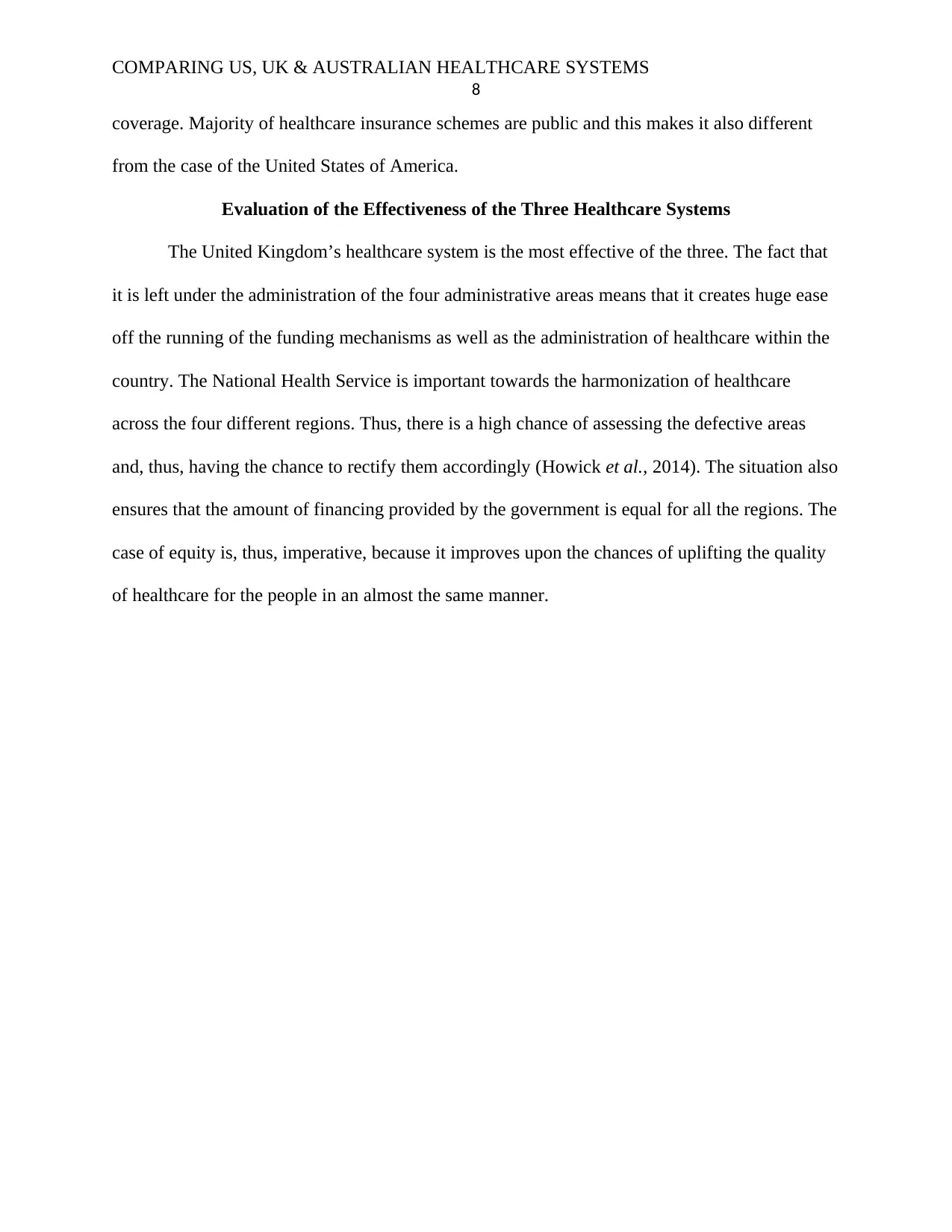
COMPARING US, UK & AUSTRALIAN HEALTHCARE SYSTEMS
8
coverage. Majority of healthcare insurance schemes are public and this makes it also different
from the case of the United States of America.
Evaluation of the Effectiveness of the Three Healthcare Systems
The United Kingdom’s healthcare system is the most effective of the three. The fact that
it is left under the administration of the four administrative areas means that it creates huge ease
off the running of the funding mechanisms as well as the administration of healthcare within the
country. The National Health Service is important towards the harmonization of healthcare
across the four different regions. Thus, there is a high chance of assessing the defective areas
and, thus, having the chance to rectify them accordingly (Howick et al., 2014). The situation also
ensures that the amount of financing provided by the government is equal for all the regions. The
case of equity is, thus, imperative, because it improves upon the chances of uplifting the quality
of healthcare for the people in an almost the same manner.
8
coverage. Majority of healthcare insurance schemes are public and this makes it also different
from the case of the United States of America.
Evaluation of the Effectiveness of the Three Healthcare Systems
The United Kingdom’s healthcare system is the most effective of the three. The fact that
it is left under the administration of the four administrative areas means that it creates huge ease
off the running of the funding mechanisms as well as the administration of healthcare within the
country. The National Health Service is important towards the harmonization of healthcare
across the four different regions. Thus, there is a high chance of assessing the defective areas
and, thus, having the chance to rectify them accordingly (Howick et al., 2014). The situation also
ensures that the amount of financing provided by the government is equal for all the regions. The
case of equity is, thus, imperative, because it improves upon the chances of uplifting the quality
of healthcare for the people in an almost the same manner.
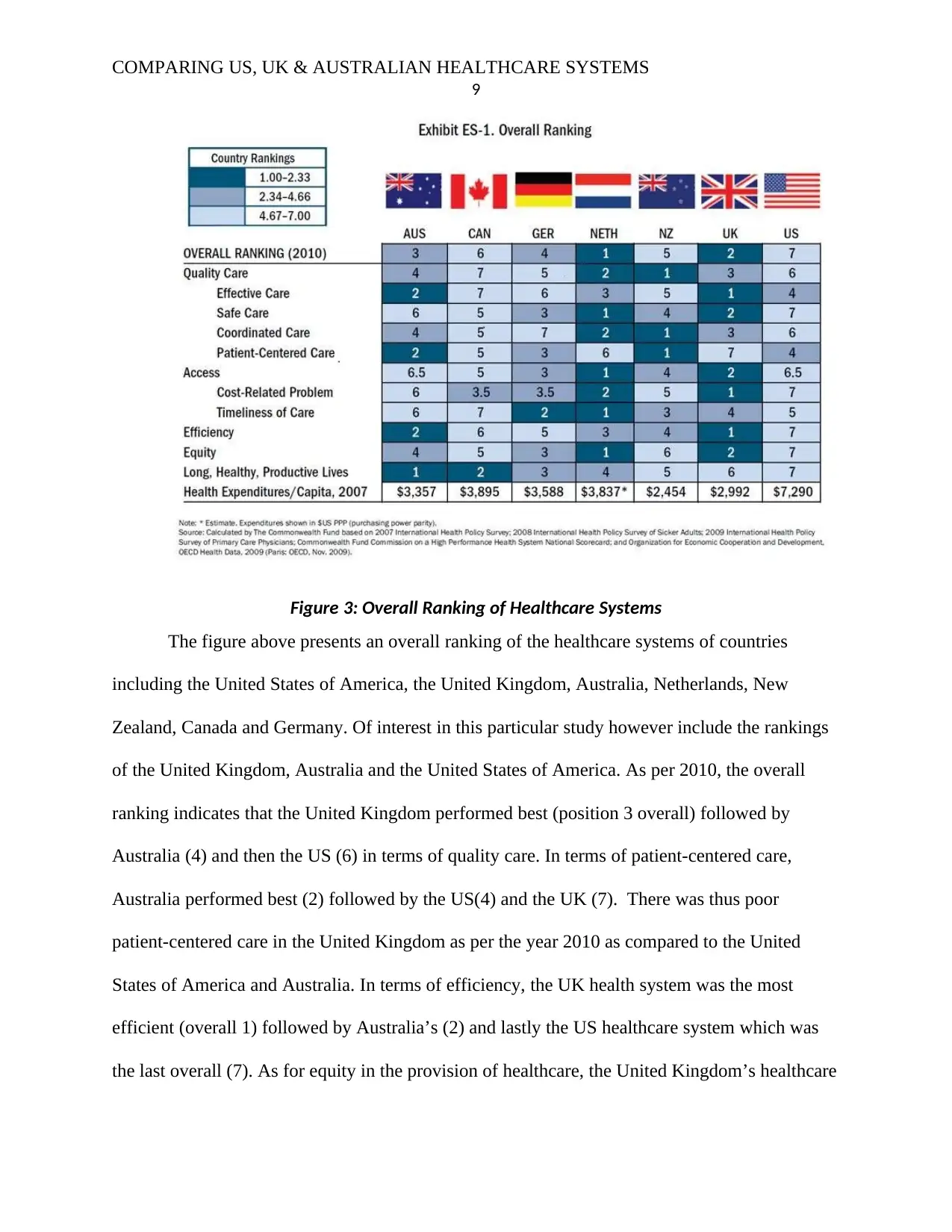
COMPARING US, UK & AUSTRALIAN HEALTHCARE SYSTEMS
9
Figure 3: Overall Ranking of Healthcare Systems
The figure above presents an overall ranking of the healthcare systems of countries
including the United States of America, the United Kingdom, Australia, Netherlands, New
Zealand, Canada and Germany. Of interest in this particular study however include the rankings
of the United Kingdom, Australia and the United States of America. As per 2010, the overall
ranking indicates that the United Kingdom performed best (position 3 overall) followed by
Australia (4) and then the US (6) in terms of quality care. In terms of patient-centered care,
Australia performed best (2) followed by the US(4) and the UK (7). There was thus poor
patient-centered care in the United Kingdom as per the year 2010 as compared to the United
States of America and Australia. In terms of efficiency, the UK health system was the most
efficient (overall 1) followed by Australia’s (2) and lastly the US healthcare system which was
the last overall (7). As for equity in the provision of healthcare, the United Kingdom’s healthcare
9
Figure 3: Overall Ranking of Healthcare Systems
The figure above presents an overall ranking of the healthcare systems of countries
including the United States of America, the United Kingdom, Australia, Netherlands, New
Zealand, Canada and Germany. Of interest in this particular study however include the rankings
of the United Kingdom, Australia and the United States of America. As per 2010, the overall
ranking indicates that the United Kingdom performed best (position 3 overall) followed by
Australia (4) and then the US (6) in terms of quality care. In terms of patient-centered care,
Australia performed best (2) followed by the US(4) and the UK (7). There was thus poor
patient-centered care in the United Kingdom as per the year 2010 as compared to the United
States of America and Australia. In terms of efficiency, the UK health system was the most
efficient (overall 1) followed by Australia’s (2) and lastly the US healthcare system which was
the last overall (7). As for equity in the provision of healthcare, the United Kingdom’s healthcare
⊘ This is a preview!⊘
Do you want full access?
Subscribe today to unlock all pages.

Trusted by 1+ million students worldwide
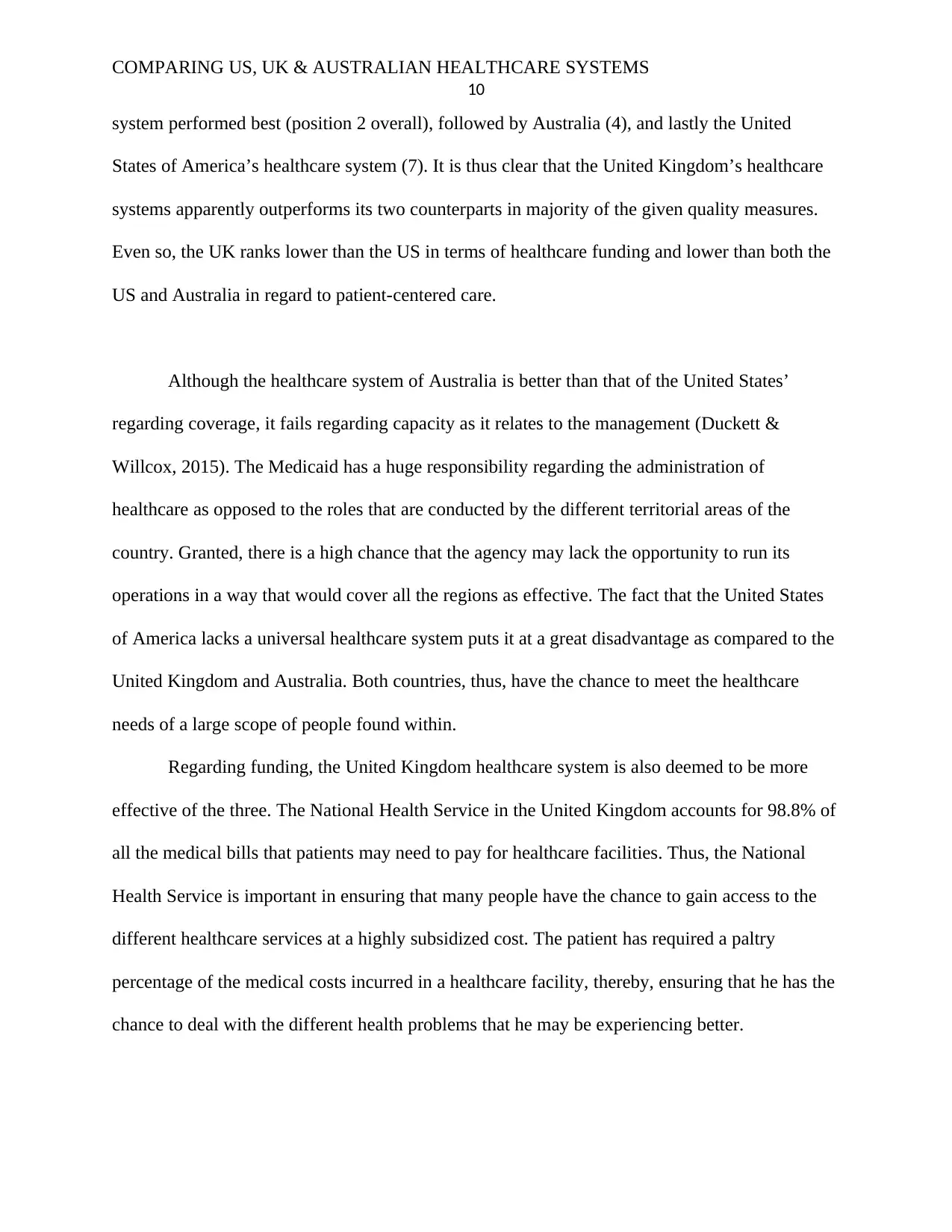
COMPARING US, UK & AUSTRALIAN HEALTHCARE SYSTEMS
10
system performed best (position 2 overall), followed by Australia (4), and lastly the United
States of America’s healthcare system (7). It is thus clear that the United Kingdom’s healthcare
systems apparently outperforms its two counterparts in majority of the given quality measures.
Even so, the UK ranks lower than the US in terms of healthcare funding and lower than both the
US and Australia in regard to patient-centered care.
Although the healthcare system of Australia is better than that of the United States’
regarding coverage, it fails regarding capacity as it relates to the management (Duckett &
Willcox, 2015). The Medicaid has a huge responsibility regarding the administration of
healthcare as opposed to the roles that are conducted by the different territorial areas of the
country. Granted, there is a high chance that the agency may lack the opportunity to run its
operations in a way that would cover all the regions as effective. The fact that the United States
of America lacks a universal healthcare system puts it at a great disadvantage as compared to the
United Kingdom and Australia. Both countries, thus, have the chance to meet the healthcare
needs of a large scope of people found within.
Regarding funding, the United Kingdom healthcare system is also deemed to be more
effective of the three. The National Health Service in the United Kingdom accounts for 98.8% of
all the medical bills that patients may need to pay for healthcare facilities. Thus, the National
Health Service is important in ensuring that many people have the chance to gain access to the
different healthcare services at a highly subsidized cost. The patient has required a paltry
percentage of the medical costs incurred in a healthcare facility, thereby, ensuring that he has the
chance to deal with the different health problems that he may be experiencing better.
10
system performed best (position 2 overall), followed by Australia (4), and lastly the United
States of America’s healthcare system (7). It is thus clear that the United Kingdom’s healthcare
systems apparently outperforms its two counterparts in majority of the given quality measures.
Even so, the UK ranks lower than the US in terms of healthcare funding and lower than both the
US and Australia in regard to patient-centered care.
Although the healthcare system of Australia is better than that of the United States’
regarding coverage, it fails regarding capacity as it relates to the management (Duckett &
Willcox, 2015). The Medicaid has a huge responsibility regarding the administration of
healthcare as opposed to the roles that are conducted by the different territorial areas of the
country. Granted, there is a high chance that the agency may lack the opportunity to run its
operations in a way that would cover all the regions as effective. The fact that the United States
of America lacks a universal healthcare system puts it at a great disadvantage as compared to the
United Kingdom and Australia. Both countries, thus, have the chance to meet the healthcare
needs of a large scope of people found within.
Regarding funding, the United Kingdom healthcare system is also deemed to be more
effective of the three. The National Health Service in the United Kingdom accounts for 98.8% of
all the medical bills that patients may need to pay for healthcare facilities. Thus, the National
Health Service is important in ensuring that many people have the chance to gain access to the
different healthcare services at a highly subsidized cost. The patient has required a paltry
percentage of the medical costs incurred in a healthcare facility, thereby, ensuring that he has the
chance to deal with the different health problems that he may be experiencing better.
Paraphrase This Document
Need a fresh take? Get an instant paraphrase of this document with our AI Paraphraser
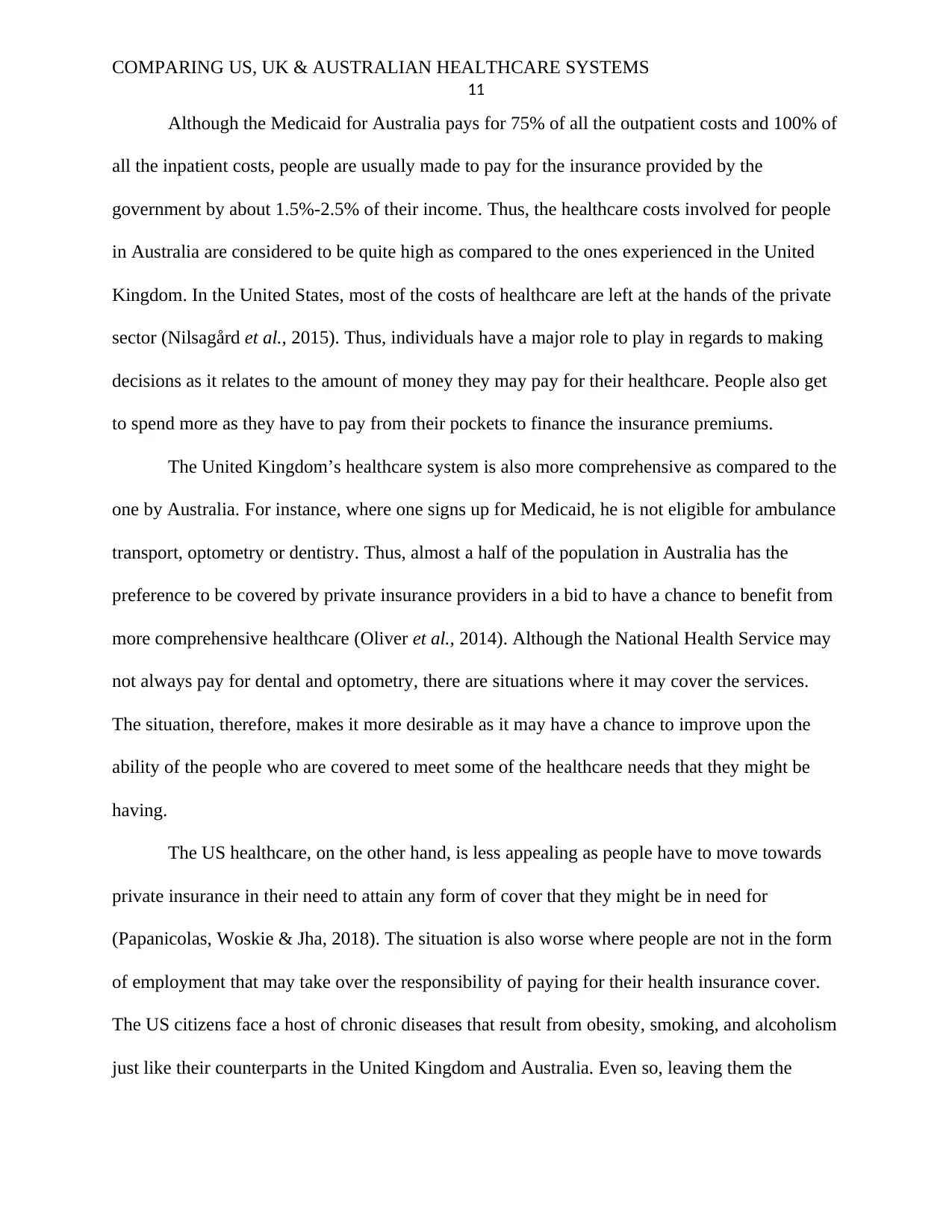
COMPARING US, UK & AUSTRALIAN HEALTHCARE SYSTEMS
11
Although the Medicaid for Australia pays for 75% of all the outpatient costs and 100% of
all the inpatient costs, people are usually made to pay for the insurance provided by the
government by about 1.5%-2.5% of their income. Thus, the healthcare costs involved for people
in Australia are considered to be quite high as compared to the ones experienced in the United
Kingdom. In the United States, most of the costs of healthcare are left at the hands of the private
sector (Nilsagård et al., 2015). Thus, individuals have a major role to play in regards to making
decisions as it relates to the amount of money they may pay for their healthcare. People also get
to spend more as they have to pay from their pockets to finance the insurance premiums.
The United Kingdom’s healthcare system is also more comprehensive as compared to the
one by Australia. For instance, where one signs up for Medicaid, he is not eligible for ambulance
transport, optometry or dentistry. Thus, almost a half of the population in Australia has the
preference to be covered by private insurance providers in a bid to have a chance to benefit from
more comprehensive healthcare (Oliver et al., 2014). Although the National Health Service may
not always pay for dental and optometry, there are situations where it may cover the services.
The situation, therefore, makes it more desirable as it may have a chance to improve upon the
ability of the people who are covered to meet some of the healthcare needs that they might be
having.
The US healthcare, on the other hand, is less appealing as people have to move towards
private insurance in their need to attain any form of cover that they might be in need for
(Papanicolas, Woskie & Jha, 2018). The situation is also worse where people are not in the form
of employment that may take over the responsibility of paying for their health insurance cover.
The US citizens face a host of chronic diseases that result from obesity, smoking, and alcoholism
just like their counterparts in the United Kingdom and Australia. Even so, leaving them the
11
Although the Medicaid for Australia pays for 75% of all the outpatient costs and 100% of
all the inpatient costs, people are usually made to pay for the insurance provided by the
government by about 1.5%-2.5% of their income. Thus, the healthcare costs involved for people
in Australia are considered to be quite high as compared to the ones experienced in the United
Kingdom. In the United States, most of the costs of healthcare are left at the hands of the private
sector (Nilsagård et al., 2015). Thus, individuals have a major role to play in regards to making
decisions as it relates to the amount of money they may pay for their healthcare. People also get
to spend more as they have to pay from their pockets to finance the insurance premiums.
The United Kingdom’s healthcare system is also more comprehensive as compared to the
one by Australia. For instance, where one signs up for Medicaid, he is not eligible for ambulance
transport, optometry or dentistry. Thus, almost a half of the population in Australia has the
preference to be covered by private insurance providers in a bid to have a chance to benefit from
more comprehensive healthcare (Oliver et al., 2014). Although the National Health Service may
not always pay for dental and optometry, there are situations where it may cover the services.
The situation, therefore, makes it more desirable as it may have a chance to improve upon the
ability of the people who are covered to meet some of the healthcare needs that they might be
having.
The US healthcare, on the other hand, is less appealing as people have to move towards
private insurance in their need to attain any form of cover that they might be in need for
(Papanicolas, Woskie & Jha, 2018). The situation is also worse where people are not in the form
of employment that may take over the responsibility of paying for their health insurance cover.
The US citizens face a host of chronic diseases that result from obesity, smoking, and alcoholism
just like their counterparts in the United Kingdom and Australia. Even so, leaving them the
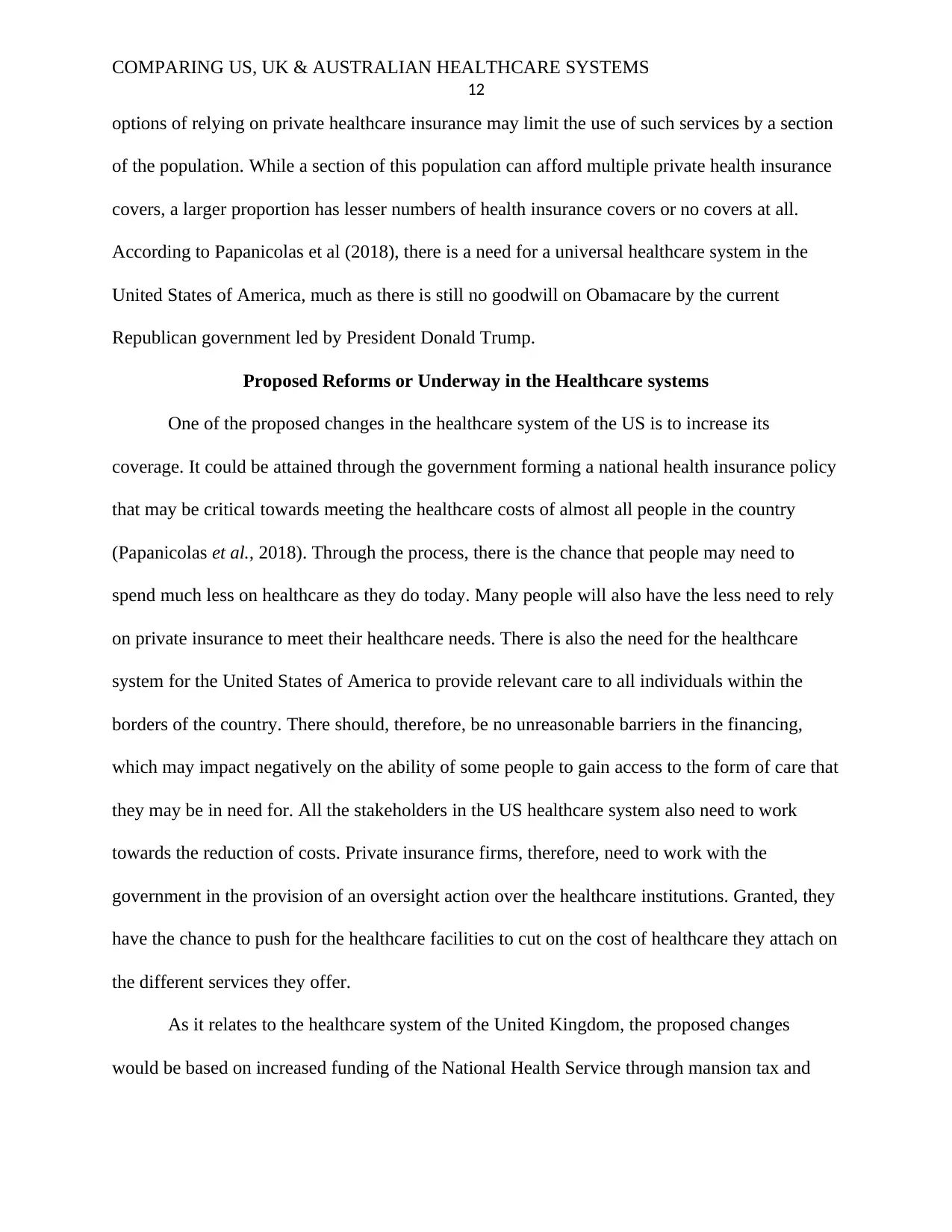
COMPARING US, UK & AUSTRALIAN HEALTHCARE SYSTEMS
12
options of relying on private healthcare insurance may limit the use of such services by a section
of the population. While a section of this population can afford multiple private health insurance
covers, a larger proportion has lesser numbers of health insurance covers or no covers at all.
According to Papanicolas et al (2018), there is a need for a universal healthcare system in the
United States of America, much as there is still no goodwill on Obamacare by the current
Republican government led by President Donald Trump.
Proposed Reforms or Underway in the Healthcare systems
One of the proposed changes in the healthcare system of the US is to increase its
coverage. It could be attained through the government forming a national health insurance policy
that may be critical towards meeting the healthcare costs of almost all people in the country
(Papanicolas et al., 2018). Through the process, there is the chance that people may need to
spend much less on healthcare as they do today. Many people will also have the less need to rely
on private insurance to meet their healthcare needs. There is also the need for the healthcare
system for the United States of America to provide relevant care to all individuals within the
borders of the country. There should, therefore, be no unreasonable barriers in the financing,
which may impact negatively on the ability of some people to gain access to the form of care that
they may be in need for. All the stakeholders in the US healthcare system also need to work
towards the reduction of costs. Private insurance firms, therefore, need to work with the
government in the provision of an oversight action over the healthcare institutions. Granted, they
have the chance to push for the healthcare facilities to cut on the cost of healthcare they attach on
the different services they offer.
As it relates to the healthcare system of the United Kingdom, the proposed changes
would be based on increased funding of the National Health Service through mansion tax and
12
options of relying on private healthcare insurance may limit the use of such services by a section
of the population. While a section of this population can afford multiple private health insurance
covers, a larger proportion has lesser numbers of health insurance covers or no covers at all.
According to Papanicolas et al (2018), there is a need for a universal healthcare system in the
United States of America, much as there is still no goodwill on Obamacare by the current
Republican government led by President Donald Trump.
Proposed Reforms or Underway in the Healthcare systems
One of the proposed changes in the healthcare system of the US is to increase its
coverage. It could be attained through the government forming a national health insurance policy
that may be critical towards meeting the healthcare costs of almost all people in the country
(Papanicolas et al., 2018). Through the process, there is the chance that people may need to
spend much less on healthcare as they do today. Many people will also have the less need to rely
on private insurance to meet their healthcare needs. There is also the need for the healthcare
system for the United States of America to provide relevant care to all individuals within the
borders of the country. There should, therefore, be no unreasonable barriers in the financing,
which may impact negatively on the ability of some people to gain access to the form of care that
they may be in need for. All the stakeholders in the US healthcare system also need to work
towards the reduction of costs. Private insurance firms, therefore, need to work with the
government in the provision of an oversight action over the healthcare institutions. Granted, they
have the chance to push for the healthcare facilities to cut on the cost of healthcare they attach on
the different services they offer.
As it relates to the healthcare system of the United Kingdom, the proposed changes
would be based on increased funding of the National Health Service through mansion tax and
⊘ This is a preview!⊘
Do you want full access?
Subscribe today to unlock all pages.

Trusted by 1+ million students worldwide
1 out of 18
Related Documents
Your All-in-One AI-Powered Toolkit for Academic Success.
+13062052269
info@desklib.com
Available 24*7 on WhatsApp / Email
![[object Object]](/_next/static/media/star-bottom.7253800d.svg)
Unlock your academic potential
Copyright © 2020–2025 A2Z Services. All Rights Reserved. Developed and managed by ZUCOL.





